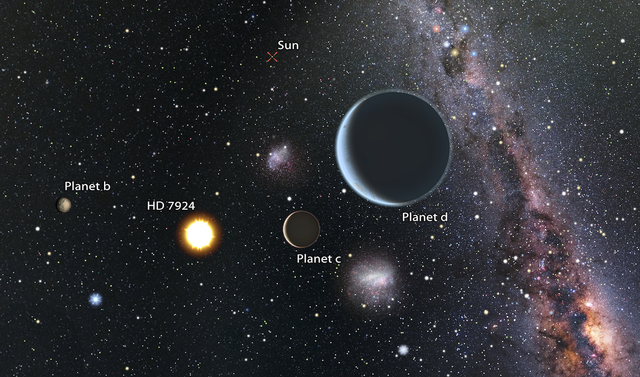While controversy swirls around the proposed Thirty Meter Telescope, astronomy work continues at Mauna Kea’s existing telescopes. ADVERTISING While controversy swirls around the proposed Thirty Meter Telescope, astronomy work continues at Mauna Kea’s existing telescopes. A team of researchers led
While controversy swirls around the proposed Thirty Meter Telescope, astronomy work continues at Mauna Kea’s existing telescopes.
A team of researchers led by the University of Hawaii at Manoa and the University of California at Berkeley this week announced the discovery of a new three-planet system orbiting a nearby star.
Data readings taken at the W.H. Keck Observatory on Mauna Kea were analyzed in conjunction with measurements from California’s Automated Planet Finder telescope and the Automatic Photometric Telescope in Arizona to confirm the existence of the system around star HD 7924.
“It’s sort of a big question in science — what is the frequency of Earth-size planets around stars nearby?” UH graduate student BJ Fulton said Tuesday. For his doctoral research, Fulton is leading a survey to determine how many “local” stars have their own planets.
Thousands of extrasolar — not in our own system — planets have been found since the launch of the Kepler space telescope in 2009, but they are close to 1,000 light-years away.
Fulton’s planetary census is an attempt to focus not on distant signals, but on stars so close that many are visible to the naked eye. HD 7924 and its planets are 54 light-years away, putting the system in relative proximity to Earth.
“What we learned from that (Kepler) is that these so-called super-Earth planets are really pretty common in our Milky Way galaxy,” UH astronomer Andrew Howard said. “But we only knew about a couple of local examples.”
Howard discovered HD 7924’s innermost planet in 2009 using readings from the 10-meter Keck 1 telescope. It took several more years and more than one dead end to lock down the entire three-planet system.
He estimated the team made more than 200 visits to the telescopes during several years, though each observation took only a couple of minutes.
The Automated Planet Finder telescope in California, which scans the skies robotically, was just as crucial to the project because it allowed the team to take readings even when they themselves weren’t present.
“We don’t take pictures (of the star),” Howard said. “It’s a little bit more esoteric.”
The movement of the star is observed with time, and any slight wobbles in its orbit are noted. The wobbles come from the gravitational pull of planets tugging on the larger central mass.
HD 7924’s other two planets were marked as candidates early on, but “these things kind of creep up on you,” Howard said. “Frankly, it took years to convince ourselves that these were real. We thought that there might be additional planets in the system.”
A fourth planetary candidate eventually was ruled out.
Though the system was first noted in the fall, it wasn’t until Tuesday that the team’s research was published.
“It’s gratifying,” Howard said. “We’re excited to showcase the science of astronomy.”
Fulton said his team hopes to discover about 10 more planets in the coming years. Exploring the nearby stars has demonstrated how diverse planetary systems can be.
The three new planets “all orbit well inside the orbit of Mercury,” Howard said. “They’re really compact, so it’s kind of surprising that they’re so different.” HD 7924’s innermost planet completes its orbit in just five days.
Each of the planets is more than seven times the mass of Earth. They are not candidates for finding signs of life.
“These planets are very hot, so these are not in the hospitable zone,” Fulton said.
Instead, researchers now must ask themselves how such a system came to be in the first place.
“It’s a puzzle to figure out how these planets were made as opposed to how those in our solar system were made,” Howard said. “This is one of the goals of our whole field.”
Email Ivy Ashe at iashe@hawaiitribune-herald.com.



